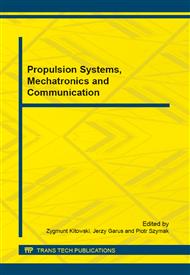p.206
p.214
p.223
p.234
p.245
p.253
p.261
p.271
p.279
Analysis of the Feasibility of Usage of Standalone Controllers for Control of Spark-Ignition Engines
Abstract:
Modern combustion engines have developed into technologically advanced units that are controlled by complex electronic systems. The controllers of these systems are equipped with built-in control algorithms which allow the engine to achieve optimum engine performance parameters, in compliance with the strict requirements of standards related to the release of toxic fumes to the atmosphere. Unfortunately, this type of engine control system very often makes it difficult to carry out research, or even prevents it, because the change of engine's regulatory parameters is not possible. Currently in most cases research carried out on this type of engine requires the construction of special controllers that allow the user to interfere with the performance of the control system. This article presents the results of tests carried out on an ignition-type engine controlled by a standalone engine.
Info:
Periodical:
Pages:
245-252
Citation:
Online since:
January 2016
Authors:
Price:
Сopyright:
© 2016 Trans Tech Publications Ltd. All Rights Reserved
Share:
Citation:


